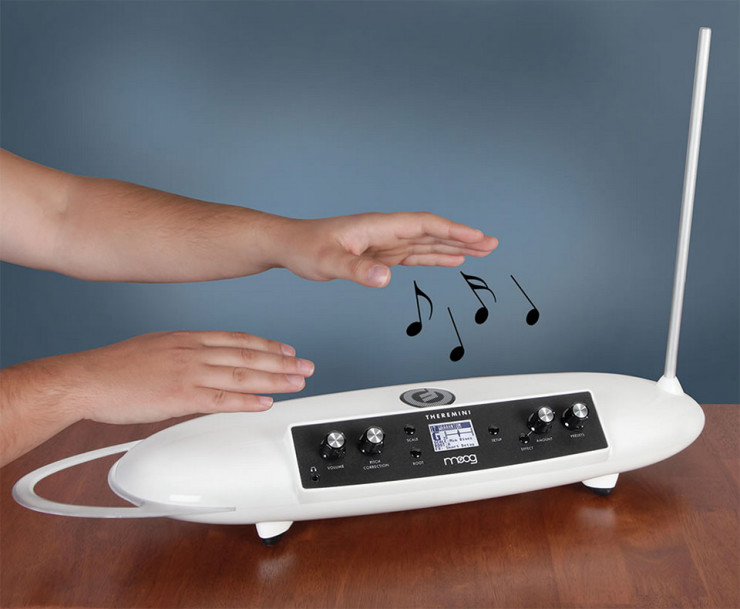Tag Archives: theremin
The Baby Head Theremin Is the Stuff of Nightmares
Are you sleeping too well? Well, let’s change that right now. The only thing creepier than the decapitated bald head of a doll is one with light-up red eyeballs, and that makes all kinds of haunting sounds when you get near it.

What you’re looking at – and about to listen to – is a custom built photo-theremin that emits those weird and wild sci-fi noises when you place your hand above its head.
The Worst Things for Sale points out that you can actually buy one of these things over on Amazon if you really want to. The XLPC Photo Theremin is available with a baby doll head, an alien head, a skull head, or in a slightly less creepy standalone version.
[via Neatorama]
Moog museum tells the history of popular synthesized music
 There's no doubt that Bob Moog had a massive influence on music by making synthesizers popular and accessible, and now there's a dedicated place to pay homage to his legacy. The Bob Moog Foundation has opened the Moogseum, a museum in Asheville, Nort...
There's no doubt that Bob Moog had a massive influence on music by making synthesizers popular and accessible, and now there's a dedicated place to pay homage to his legacy. The Bob Moog Foundation has opened the Moogseum, a museum in Asheville, Nort...
Moog Theremini is a Thermin For The Rest Of Us

If you’ve ever heard a Theremin, you might’ve become intrigued by this otherworldly instrument. Used for decades as the eerie instrument in countless movies, as well as being popular with psychedelic rock bands of the 70’s, the Theremin is intriguing but also hard to play. The Moog Theremini Professional Theremin on the other hand tries to simplify the experience so that even amateurs can have a hope to, well, not suck.
First, it’s got a powerful sound engine derived from Moogs award winning synthesizer: Animoog. Second, and this is a first for Theremins, the Theremini has assistive pitch quantization, which allows you to adjust the instrument’s level of playing difficulty. At the maximum position, the Theremini will play every note in a selected scale perfectly, making it impossible to play a wrong note. As this control is decreased, more expressive control of pitch and vibrato becomes possible. The Theremini is a dream to play, a marvel to compose with, and a work of art to look upon.
This particular instrument is far from being a toy, since it is produced by the groundbreaking Moog Music company and costs $300. If you’ve got an experimental music inclination, this could be your chance to experiment with what many consider to be the very first electric instrument ever created.
[ Product Page ] VIA [ Technabob ]
The post Moog Theremini is a Thermin For The Rest Of Us appeared first on OhGizmo!.
Moog Theremini: The Accessible Theremin
Ever wanted to play a theremin just so you could play the opening theme song from Star Trek? Most theremins are expensive and extremely difficult to master. On the other hand, this modern theremin by Moog is only about $300 and includes features to help you learn how to play it correctly.
Like the original, the Moog Theremini is played by waving your hand in proximity to the instrument’s antenna. But this new version provides visual feedback to help ensure your hand is placed correctly. It also offers assistive pitch quantization – which is fancy talk for saying you can’t play a bad note. This feature can be adjusted based on your skill level. It’s also capable of playing 32 different sounds – not just the traditional outer space whine we all know and love, but a wide variety of otherworldly sounds.
You can get the Moog Theremini over at Hammacher Schlemmer or ThinkGeek now.
DIY theremin goggles marry the art of noise with steampunk style (video)
Sometimes annoying just isn't annoying enough. For DIY enthusiast and self-described "maker of awesome" Sarah Petkus, the incentive to irk was merely a happy by-product of her latest goggle design. The steampunk-ish effort, chronicled on Petkus' blog Robotic Arts, combines some artfully arranged scrap metals with an integrated optical theremin that lets the wearer manipulate an incredibly unpleasant tone just by waving their hands and adjusting the amount of light fed into the sensors. Since the volume control and speaker are housed inside the eyepieces, the goggles are little more than a head-mounted accessory. But that shouldn't stop cosplay types (or sociopaths) from strapping on a set and tweaking the nerves of unfortunate passers-by. That's if Petkus gets around to selling the "eyewear." For the public's sake, we hope this inventive mod remains a one-off. Head past the break for a video demo of this cringe-inducing, gesture-controlled cacaphony.
Via: Adafruit
Source: Robotic Arts
Light Hum: a pure analog theremin that converts rays into electro-grooves (video)
Who doesn't love a good theremin spectacle? We Engadgeteers are aficionados of the touchless, variable capacitor musical instrument used in countless '50s space films, so a project by student and designer Danne Woo definitely caught our eye. Woo, who appeared on one of our most popular Engadget shows ever, has built a light-sensing version of that instrument controlled by an AC sequencer. No computers are used in the all-analog device, which is played by moving sliders and dials that vary the intensity of eight lamps installed in front of the musician. The light is converted to varying-frequency sound via photocells, resistors and capacitors which feed a "kleebtronics sequencer" designed by Mark Kleback and Ezer Lichtenstein. To show what it could do, Danne performed a short concert at Glasslands in Brooklyn, bringing the "Good Vibrations" instrument to a whole 'nother place -- catch it in the video after the break.
Continue reading Light Hum: a pure analog theremin that converts rays into electro-grooves (video)
Filed under: Misc
Source: Danne Woo Blog (1), (2)
Miselu Neiro synth at Google I/O: exclusive first look at apps from Korg and Yamaha (video)
Remember Miselu's Neiro -- that prototype app-based Android-powered synth we last played with at SXSW? Not only is it being showcased at Google I/O 2012 here in San Francisco, but we got an exclusive first look at some of the apps being developed for the new platform ahead of the event. The company's been on a roll since our meeting in Austin, gaining (ex-OQO CEO) Jory Bell as CTO and building relationships with partners like Korg and Yamaha.
Now on its second iteration, the laptop-like synth has evolved from the hand-built prototype we saw at SXSW to a more polished reference design -- complete with breakout board for SD card and Ethernet support. As before, the device runs Gingerbread on a dual-core TI OMAP processor and features a two octave velocity and pressure-sensitive keyboard, a capacitive multitouch widescreen, WiFi and Bluetooth connectivity, audio and MIDI I/O, plus USB and HDMI ports. This version even adds XLR and quarter-inch audio jacks -- just keep in mind that those specs have not been finalized.
What's really exciting about the synth is the apps. The company's ongoing partnership with Retronyms to create a suite of touch-controlled, cloud-enabled musical apps has evolved beyond the drum-machine demo we covered at SXSW. Called nStudio, the suite now also includes a pad-based sampler / sequencer and a mixer. Plasma Sound is a touch-based musical instrument that's part theremin, part keyboard / sequencer. It's already available for other devices on Google Play, but was easily tweaked to run on the Neiro -- sight unseen -- thanks to Miselu's musicSDK and OS X-based emulator.
Miselu will be showcasing two more apps on its synth here at Google I/O: Korg's Polysix and Yamaha's Vocaloid. The Polysix app fainthfully recreates Korg's legendary 1981 synth -- known for its rich, thick analog sound. A real, mint-condition Polysix was even available for comparison during our brief time with the app (see our gallery). Vocaloid takes full advantage of the NSX-1 DSP chip that's built-into the Neiro. It's a singing synth app produced by Yamaha that "uses concatenative synthesis to splice and process vocal fragments extracted from human voice samples."
We'll be spending some time with the Vocaloid app and its creator -- video game designer Tetsuya Mizuguchi (of Sega and Lumines fame) -- later today. In the meantime, check out the gallery below and watch our hands-on video with the other apps after the break.
Miselu Neiro synth at Google I/O: exclusive first look at apps from Korg and Yamaha (video) originally appeared on Engadget on Wed, 27 Jun 2012 12:00:00 EDT. Please see our terms for use of feeds.
Permalink | Miselu (1), (2), (3) | Email this | Comments
Miselu (1), (2), (3) | Email this | Comments 








